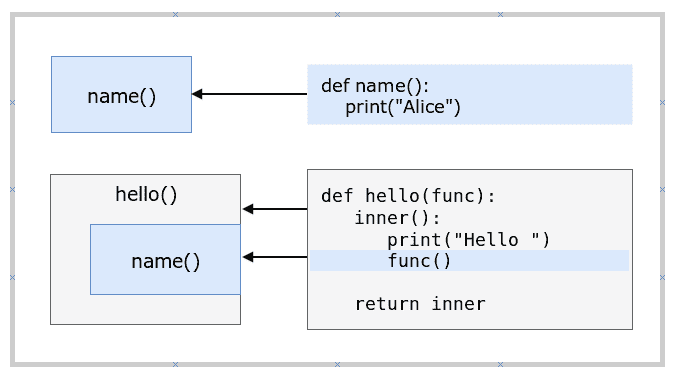# 装饰器
> 原文: [https://pythonbasics.org/decorators/](https://pythonbasics.org/decorators/)
在本教程中学习 **Python 装饰器**。
使用装饰器向现有函数添加功能。 这称为元编程。
一个函数可以将一个函数作为参数(要修饰的函数),并返回带或不带扩展名的相同函数。
扩展函数有时非常有用,我们将在本文稍后展示真实的示例。
### 函数是对象
在 Python 中,一切都是对象,包括函数。 这意味着函数可以传递并返回。 当您看到它时,乍一看可能很奇怪:
```py
def hello():
print("Hello")
# even functions are objects
message = hello
# call new function
message()
```
调用`message()`或`hello()`方法,它们具有相同的输出。 那是因为他们指的是同一个对象。
现在让我们继续装饰。
## 装饰器
### 示例
装饰器接受一个函数,对其进行扩展并返回。 是的,**函数可以返回函数**。
```py
def hello(func):
def inner():
print("Hello ")
func()
return inner
def name():
print("Alice")
obj = hello(name)
obj()
```
在上面的示例中,`hello()`是装饰器。
在
语句中
```py
obj = hello(name)
```
函数`name()`由函数`hello()`装饰。
它将函数包装在另一个函数中。

### 示例 2
可以通过包装函数来扩展它们。
```py
def who():
print("Alice")
def display(func):
def inner():
print("The current user is : ", end="")
func()
return inner
if __name__ == "__main__":
myobj = display(who)
myobj()
```
`who()`函数由`display()`装饰。
### 语法糖
装饰器是常见的,可以简化。 尽管功能完全相同,但代码更简洁。
Python 可以使用**`@`符号**简化装饰器的使用。
```py
@hello
def name():
print("Alice")
if __name__ == "__main__":
name()
```
这将输出完全相同的内容,但是是编写代码的更简洁的方法。
跟我在一起。调用:
```py
@hello
def name():
```
只是一种更简单的书写方式:
```py
obj = hello(name)
```
在这两种情况下,我们都将装饰器应用于函数。
### 参数
参数可以与装饰器一起使用。 如果您有一个打印总和`a + b`的函数,例如
```py
def sumab(a,b):
summed = a + b
print(summed)
```
您可以将其包装在装饰器函数中。以下示例显示了如何执行此操作:
```py
def pretty_sumab(func):
def inner(a,b):
print(str(a) + " + " + str(b) + " is ", end="")
return func(a,b)
return inner
@pretty_sumab
def sumab(a,b):
summed = a + b
print(summed)
if __name__ == "__main__":
sumab(5,3)
```
函数`sumab`由函数`pretty_sumab`包装。 这用其上方的`@`符号表示。
调用函数`sumab`,并查看带有参数的函数`sumab`和`pretty_sumab`的逻辑都已运行。
### 真实示例
**用例:时间测量**

装饰器可用于测量函数执行所需的时间。
如果您定义了一个休眠的简单函数,则
```py
def myFunction(n):
time.sleep(n)
```
然后,您只需添加`@measure_time`行即可测量所需的时间
下面的例子:
```py
import time
def measure_time(func):
def wrapper(*arg):
t = time.time()
res = func(*arg)
print("Function took " + str(time.time()-t) + " seconds to run")
return res
return wrapper
@measure_time
def myFunction(n):
time.sleep(n)
if __name__ == "__main__":
myFunction(2)
```
这将输出执行函数`myFunction()`所花费的时间。 很酷的事情是,通过添加一行代码`@measure_time`,我们现在可以测量程序执行时间。

**用例:Web 应用程序**
让我们以 Web 应用程序的使用案例为例。 在 Flask 中构建 Web 应用程序时,您始终会编写网址路由。
每个路由都是 Web 应用程序中的特定页面。打开页面`/about`可以调用`about_page()`方法。
```py
@app.route("/about")
def about_page():
return "Website about nachos"
```
在这种情况下,它使用`@`符号进行装饰。
[下载示例和练习](https://gum.co/dcsp)
- 介绍
- 学习 python 的 7 个理由
- 为什么 Python 很棒
- 学习 Python
- 入门
- 执行 Python 脚本
- 变量
- 字符串
- 字符串替换
- 字符串连接
- 字符串查找
- 分割
- 随机数
- 键盘输入
- 控制结构
- if语句
- for循环
- while循环
- 数据与操作
- 函数
- 列表
- 列表操作
- 排序列表
- range函数
- 字典
- 读取文件
- 写入文件
- 嵌套循环
- 切片
- 多个返回值
- 作用域
- 时间和日期
- try except
- 如何使用pip和 pypi
- 面向对象
- 类
- 构造函数
- 获取器和设置器
- 模块
- 继承
- 静态方法
- 可迭代对象
- Python 类方法
- 多重继承
- 高级
- 虚拟环境
- 枚举
- Pickle
- 正则表达式
- JSON 和 python
- python 读取 json 文件
- 装饰器
- 网络服务器
- 音频
- 用 Python 播放声音
- python 文字转语音
- 将 MP3 转换为 WAV
- 转录音频
- Tkinter
- Tkinter
- Tkinter 按钮
- Tkinter 菜单
- Tkinter 标签
- Tkinter 图片
- Tkinter 画布
- Tkinter 复选框
- Tkinter 输入框
- Tkinter 文件对话框
- Tkinter 框架
- Tkinter 列表框
- Tkinter 消息框
- Tkinter 单选按钮
- Tkinter 刻度
- 绘图
- Matplotlib 条形图
- Matplotlib 折线图
- Seaborn 分布图
- Seaborn 绘图
- Seaborn 箱形图
- Seaborn 热力图
- Seaborn 直线图
- Seaborn 成对图
- Seaborn 调色板
- Seaborn Pandas
- Seaborn 散点图
- Plotly
- PyQt
- PyQt
- 安装 PyQt
- PyQt Hello World
- PyQt 按钮
- PyQt QMessageBox
- PyQt 网格
- QLineEdit
- PyQT QPixmap
- PyQt 组合框
- QCheckBox
- QSlider
- 进度条
- PyQt 表格
- QVBoxLayout
- PyQt 样式
- 编译 PyQt 到 EXE
- QDial
- QCheckBox
- PyQt 单选按钮
- PyQt 分组框
- PyQt 工具提示
- PyQt 工具箱
- PyQt 工具栏
- PyQt 菜单栏
- PyQt 标签小部件
- PyQt 自动补全
- PyQt 列表框
- PyQt 输入对话框
- Qt Designer Python
- 机器学习
- 数据科学
- 如何从机器学习和 AI 认真地起步
- 为什么要使用 Python 进行机器学习?
- 机器学习库
- 什么是机器学习?
- 区分机器学习,深度学习和 AI?
- 机器学习
- 机器学习算法比较
- 为什么要使用 Scikit-Learn?
- 如何在 Python 中加载机器学习数据
- 机器学习分类器
- 机器学习回归
- Python 中的多项式回归
- 决策树
- k 最近邻
- 训练测试拆分
- 人脸检测
- 如何为 scikit-learn 机器学习准备数据
- Selenium
- Selenium 浏览器
- Selenium Cookie
- Selenium 执行 JavaScript
- Selenium 按 ID 查找元素
- Selenium 无头 Firefox
- Selenium Firefox
- Selenium 获取 HTML
- Selenium 键盘
- Selenium 最大化
- Selenium 截图
- Selenium 向下滚动
- Selenium 切换到窗口
- Selenium 等待页面加载
- Flask 教程
- Flask 教程:Hello World
- Flask 教程:模板
- Flask 教程:路由
